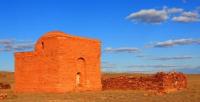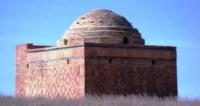You are here
Ulytau monuments.


Tours sights of monuments of Ulytau.
“Ancient aphorisms outlived centuries. Modern aphorisms can barеly survive from book to book”
Ljupka Cvetanova.
Ancient monuments Zhezkazgan of steppes.
Ulytau is a historical centre of the Kazakh people and epicenter of nomadic culture of the steppe civilization. People named them “The Great Mountains’ their historical and political importance in national history. Many encampments of ancient people and their instruments of labour were discovered here.
These ancient majestic mountains played a significant role in the events of Kazakhstan's history. Ulytau was the favourite place of khans of various nomadic tribes. There headquarter of Khan Jochi, the eldest son of the great Genghis Khan, were set up here. It was here that Khan Batyi started his military campaign from.
These places are famous for the fact that many famous historical or religious figures, which lived in the X-XVIII century, were buried here. The Ulytau monuments are as important as many other monuments of abovementioned places.
For example, Alashakhan, the ruler of the Alash Horde (the Western- Turkic Khaganate), lived in the VII - VIII century. The mausoleum that we see today was later built by the Kazakh khans (the XIII century) to designate the headquarters and revive the old fame of the Alash Horde.
The mazar of the eldest son of Genghis Khan, Jochi Khan, was built for the same purpose. The Golden Horde khans, such as Tokhtamysh, the great Horde commander Emir Odegey, were buried here. Their names are crowned with immortality in folk legends of Altai, Ural, Crimea, North Caucasus and Uzbekistan.
In spring of 1391, the great Tamerlan left a record of his stay on stone rocks of the Ulytau mountain, Altynshoky. Every nation has sacred places that are mentioned in mythology. The name "Auliye" (Sacred) of the Turk people of Central Asia indicated the presence of sacred space in ritual life.
As a rule, this place functioned according to its ritual laws in ancient times. Having chosen the place of worship, people would come there to perform their rituals. From time immemorial, a mountain has been a sacred place.
It was believed to be inhabited by gods and spirits, and sacred forces. It is here that people performed their ritual rites and felt the connection and oneness with the nature. To restore the vital force, people returned to the cradle of their ancestors and sacred places - the infinite source of strength and place of worship.
Ulytau is the place to have housed khan residencies and conservation areas. Nomads sacral- ized the area due to many reasons that are understood only on subconscious levels. Archeologist B.E. Kumekov, while analyzing the Arabian sources of the Middle Age, determined, that the Kimaks and Kypshaks that inhabited Ulytau, led a settled way of life, engaged in trade and craft.
According to Maksud Kukistan, the Ulytau mountains housed the headquarters of Abulkhair Khan and Horde Bazaar, "...which was the capital of the medieval state Desht-and-Kypshak and the fame of sultans of all sultans".
As per the description of an Arabian scientist Al-ldrisi, whose itinerary included the Ulytau steppes, "the Kimaks had 16 towns". Another medieval traveler named Gardizia, Ulytau had a sacred place with petro- glyphs, a well with therapeutic waters.
The local Turks worshipped this place. In 1993, archeologist J.E. Smailov counted 9 mediaeval ancient settlements and fortifications in the Ulytau region. The monuments, preserved in Ulytau, date back to the Paleolithic and late Stone Age.
The scientists discovered numerous encampments of ancient people and their instruments of labour. They excavated the largest in Kazakhstan workshop of the Bronze Age on the banks of the Karakengir river, featuring settlements, burials grounds and artifacts of ancient culture.
To present day, the mystery of the "moustached burial mounds" has not been solved. Some arche- ologists suggest that they are grave constructions, other say that it is an ancient observatory, and some conclude that it is a ritual complex.
Archeological excavations prove that 3 thousands years ago, the local tribes engaged in mining and exported copper, tin, silver and gold to Iran, India and Greece. Ulytau is called the country of mountains, lakes and springs.
The therapeutic properties of highland spring waters of Ulytau were known far beyond the limits of this region. Russian and European ambassadors, leaving for Karakorum, the main headquarter of the Tatar-Mongols, made sure to stop over at this place to receive treatment in the Ulytau spring waters.
A branch of the Great Silk Road, the so-called Sarysysyisk or copper route, passed through Ulytau from Central Asia to Siberia. The scientists presume that this route had existed long before the Silk Road, and was used till the 30's of the last century.
Ancient mysteries and untouched nature await you in Ulytau. Saryarka played a key role in the development of the Kazakh Khanate, consolidation and education of the Kazakh .people. Grand burial sites, necropolises, mausoleums of the Begazy-Dandybay culture, petroglyphs, mines, iron-and-steel furnaces and other ancient monuments discovered and examined by the scientists indicate that Ulytau was the centre of Saryarka and the entire steppe in ancient times.
For this reason, on November 29, 1990 as per the Enactment of the Council of Ministers of the Kazakh SSR, the National Historical and Cultural Museum of Ulytau was founded. Its territory comprises18 million ha.
Under the Cultural Heritage project founded on June 13, 2008, the Ulytau mountains were made part of the national symbols and the Gold Treasury of statehood. The pyramid-shaped Palace of Peace and Concord was built in the capital of Kazakhstan, Astana.
The Head of State chosen this form from a great number of projects, proposed by architects from all over the world. "We are not building a pyramid but a mountain, since a pyramid is a man made model of a mountain, the prototype of the great Ulytau". The mountain is an image of motherland.
The Kazakhs have many other sacred mountains, but all of them are the embodiment of one single mountain, the Ulytau, Uly Ana.
Authority:
The guidebook across Kazakhstan. The edition of the ministry of tourism and sports.
Photos by:
Alexander Petrov.







